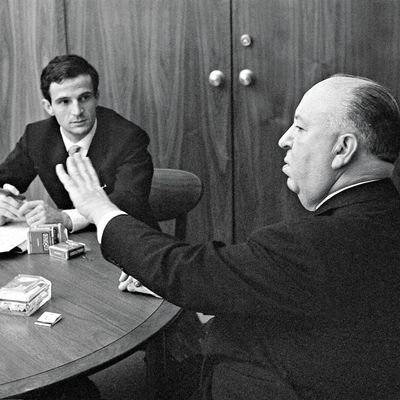
Quite aside from being one of the most insightful and influential film books ever written, Francois Truffaut’s Hitchcock/Truffaut also has the distinction of being one of those volumes many budding film buffs come to early in life. I first came across it when I was 12 or so, after my dad bought Truffaut’s updated 1985 reissue. I’ve spoken to at least five other critics recently who first read it around these ages as well. And now here is David Fincher, in the opening scenes of Kent Jones’s fascinating new documentary, Hitchcock/Truffaut, talking about how he first read it as a young kid, after his dad gave it to him. Which is odd, because Hitchcock/Truffaut is not a simple, kid-friendly book. It’s pages and pages of two directors talking about craft and art, and about films most children aren’t even allowed to see. But the book has clarity, and authority, and, yes, pictures. As the two directors speak, you can see — through images, collages, multi-page spreads of frame progressions — that they’re not just kicking air. It’s still probably one of the greatest introductions to what a director does.
When Truffaut first interviewed Hitchcock, the older man was enormously successful, virtually a household name. But he didn’t quite have the kind of critical respect that some felt he was due; to many, he was a popular entertainer, not a true film artist. And Hitchcock/Truffaut wasn’t just an attempt to explore Hitchcock’s technique, but also to discuss the bigger issues at play in his work — themes like spirituality, guilt, shame, and obsession. Truffaut and his compatriots at Cahiers du Cinema had been making the case for Hitchcock for some years, but this book was probably one of the biggest weapons in the battle to claim the filmmaker as an artist of the highest order.
It worked, and Jones’s film doesn’t need to fight that particular battle. Rather, it’s more interested in making a case for the continuing relevance of Hitchcock’s work. (The film’s opening words come from Hitchcock himself, mulling Truffaut’s question about why his films haven’t aged.) So, we get a series of notable directors — Fincher, Richard Linklater, Martin Scorsese, Wes Anderson, Olivier Assayas, and others — reflecting on the book and Hitchcock’s importance to them. But the film is more than just a tribute; it’s a kind of re-enactment. Using a combination of the original audio files of Truffaut’s interviews, along with these directors offering up their own interpretations and analyses of Hitchcock’s work, the film, in the limited amount of time it has, replicates the effect of the book.
The results are fascinating. Linklater, Scorsese, and Assayas riff on Truffaut’s contention that Hitchcock’s pointed cuts to wide shots and high overhead angles represent a spiritual point-of-view. Arnaud Desplechin talks about objects, icons, and the transfer of guilt. Scorsese walks us through the first act of Psycho, from the purposeful blandness of the early scenes in Janet Leigh’s office to the meditative quality of her fateful drive to Bates Motel. These are some of our greatest cinematic minds explaining what it is that makes Hitchcock’s work not just so effective, but also so haunting and resonant. (It also lends support to one of my pet theories, which is that filmmakers often make the best film critics.)
Hitchcock/Truffaut is a brisk 80 minutes long, and it’s certainly not complete, nor does it pretend to be. Toward the end, the directors discuss how out of step Hitchcock’s language is from the heavy visual and narrative bombardment of today’s media culture; I don’t know if Jones tried to get him, but this is where I would have loved to hear from Gus Van Sant, he of the famously disastrous shot-for-shot remake of Psycho. Others have noted the absence of any female directors among the interviewees, which is unfortunate, since Hitchcock’s work is so fraught with sexual tension. At one point, James Gray fascinatingly breaks down the male gaze in Vertigo, making the point that Jimmy Stewart’s gaze is the only one that matters in the film — since the whole movie is a ruse designed to rope him in through his attraction to Kim Novak’s character. And yet the writer Lauren Wilford recently explored the flipside of this notion in a wonderful essay called “Possessed: Vertigo Through Her Eyes.” That’s not a knock on Gray’s incisive analysis, or Jones’s excellent film. Rather, it’s further proof of how vital Hitchcock’s work remains for so many after all these years. This film is a worthy contribution to that legacy.


